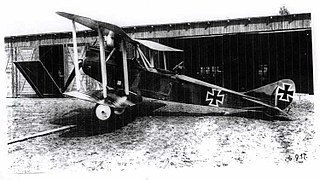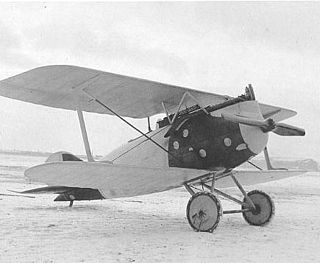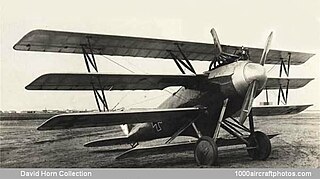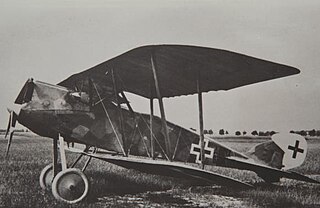
The Rumpler C.IV was a German single-engine, two-seat reconnaissance biplane. It was a development of C.III with different tail surfaces and using a Mercedes D.IVa engine in place of the C.III's Benz Bz.IV. The Rumpler 6B 2 was a single-seat floatplane fighter variant with a 120 kW (160 hp) Mercedes D.III engine built for the Kaiserliche Marine.

The Daimler D.I was a German fighter aircraft of World War I. It was a conventional biplane design with a very small interplane gap - the top wing nearly touched the top of the fuselage. Power was provided by a Daimler D.IIIb water-cooled V-8 engine.

The LFG Roland D.I was a fighter aircraft produced in Germany during World War I. It was a single-seat aircraft based originally on the Roland C.II two-seat reconnaissance type. It shared its predecessor's unusual design feature of having a deep fuselage that completely filled the interplane gap, but in comparison, the fuselage was much sleeker. While the C.II's appearance had earned the Walfisch ("Whale"), the D.I became known as the Haifisch ("Shark"). The I-struts that had been used to brace the C.II's wing were replaced by more conventional struts. Other changes to the wing included the removal of stagger from the design and the introduction of slight sweepback.

The Rumpler D.I was a fighter-reconnaissance aircraft produced in Germany at the end of World War I. It was a conventional single-bay biplane with wings of unequal span braced by I-struts. It featured an open cockpit and a fixed, tailskid undercarriage. The upper wing was fitted with aerodynamically balanced ailerons and fuselage had an oval cross-section.

The Daimler L11 was a German single-seat, parasol-wing, monoplane fighter built during the First World War for the Imperial German Air Service. A single prototype was built in 1918, but the war ended before it could be accepted for service. The two-seat Daimler L14 was based on this aircraft.

The Aviatik D.III was a German prototype single-seater fighter plane from the First World War, designed by Aviatik. It became the basis for the Aviatik D.IV and Aviatik D.V. In November 1917, the plane was first flown, using a 195 hp Benz Bz IIIbo gearless engine. It was of similar design to the Aviatik D.II, and was armed with two LMG 08/15 machine guns. After several tests at Adlershof from February 9–12, 1918, the plane underwent modifications, as requested by the Idflieg. In April, a second prototype, powered by a Benz Bz IIIbm, although several D.III powered by the original IIIbo engine were already under production; however, none of them were ever completed.
The Kondor E 3, sometimes erroneously known as E.III, was a German single seat, monoplane fighter aircraft designed and built close to the end of World War I. Though successful in the third D-type fighter competition at Aldershof in September 1918, only a few were produced, given the Idflieg designation of Kondor D.I.

The Kondor D 6 was a prototype German biplane fighter aircraft flown in 1918. In the interests of better upward vision for the pilot, its upper wing was in two halves, separated over the central fuselage. Its development was soon abandoned.

The Naglo D.II was a German single seat quadruplane fighter, flown late in World War I. It took part in one of the fighter competitions but did not reach production.
The Pfalz D.VI was a German sesquiplane fighter aircraft from World War I. It was not put into production.
The Schütte-Lanz D.VII was a single engine, biplane fighter aircraft designed and built in Germany towards the end of World War I.

The Aviatik D.VII was a prototype German single-seat biplane fighter aircraft built by Aviatik in the last year of the First World War. It could not participate in the Third Fighter Competition of October 1918 because it used the wrong engine and it saw no military service, although 50 aircraft were found in storage after the war. The only real major change from the earlier Aviatik D.VI was a completely new tail structure.

The Aviatik C.IX was a prototype German observation aircraft built by Aviatik in the final months of World War I.

The Kondor D 2 was a German single seat, biplane fighter aircraft designed and built close to the end of World War I.

The Friedrichshafen D.I was a German single-seat fighter plane developed by the Flugzeugbau Friedrichshafen during the First World War. Two prototypes were flown in 1917, but it was judged inferior to the Albatros D.III then in production and no further production ensued.

The Aviatik D.VI was a German prototype single-seater fighter aircraft of the First World War, designed by Aviatik.

The Naglo D.I was a German single seat quadruplane fighter, flown late in World War I. It took part in one of the fighter competitions but did not reach production.
The LVG D.III was a German fighter plane built by LVG in World War I.

The LVG D.VI was a prototype German biplane fighter built by LVG in World War I.
The Märkische D.I was a prototype single-seat fighter biplane built in the last months of World War I.

















